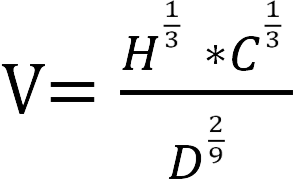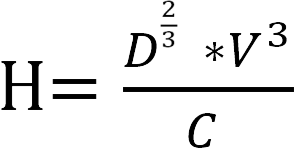Using the Admiralty Constant to Estimate Submerged Speeds for Submarines(Created 3 April 2021) |
Using the Admiralty Constant to Estimate Submerged Speeds for Submarines(Created 3 April 2021) |
From reading Eberhard Rössler's The U-Boat: The Evolution and Technical History of German Submarines, it became apparent that you can use the Admiralty Constant to estimate the submerged performance of a submarine.
The Admiralty Constant (or Coefficient) was originally developed in the mid to late 19th Century to help compare different types of ships and calculate their overall efficiency.
It soon fell out of use other than as a "beginner equation" to introduce Marine Engineering students to performance modeling because it didn't take into account wave motion, which is a significant factor affecting the performance of a surface ship.
However, submerged submarines don't have to worry about wave motion...
The original Admiralty Constant equation is:

Where:
C = Admiralty Constant
D = Submerged Displacement (Long tons)
V = Speed (Knots)
H = Submerged Power (Horsepower)
Reversed equations for different variables in the Constant, generated via the online algebraic calculator (HERE) are:

and

and

An interactive calculator implementing all of the above equations has been prepared for your ease of use below:
Find for C Coefficient Calculation|
CALCULATIONS OUTPUT: |
Per the data in Gabler's Submarine Construction (7.3~ MB PDF) along with other sources (Rössler) and Cold War Submarines, the following constants can be calculated:
|
World War II Non-Streamlined Submarines |
||||
|
Type |
C |
Submerged Displacement |
Maximum |
Submerged Power (HP) |
|
Type IIB |
44.853 |
323 |
7 |
360 |
|
Type VIIC |
52.808 |
857 |
7.6 |
750 |
|
Type IXB |
42.923 |
1,159 |
7.3 |
1,000 |
|
USN WW2 Fleet Boat |
44.313 |
2,440 |
8.75 |
2,740 |
|
WW2 Submarine Mean |
44.58 |
– |
– |
– |
|
18 in. Mk. XII Torpedo |
357.328 |
0.6910714 |
40 |
140 |
|
Type 93 “Long Lance” Torp. |
441.532 |
2.726252 |
49 |
520 |
|
World War II and Post-War Streamlined Submarines |
||||
|
Type |
C |
Submerged Displacement |
Maximum |
Submerged Power (HP) |
|
K-1 (SSK-1) |
64.571 |
1,160 |
8.5 |
1,050 |
|
USN Fleet Snorkel |
66.146 |
2,440 |
10 |
2,740 |
|
Type XXI |
120.769 |
1,790 |
16 |
5,000 |
|
HMS Explorer |
132.537 |
1,203 |
26 |
15,000 |
|
Type XXIII |
135.059 |
254 |
12.5 |
580 |
|
USN 1947 SS |
152.722 |
1,550 |
17.5 |
4,700 |
|
GUPPY II |
159.269 |
2,400 |
16 |
4,610 |
|
Skate (SSN-578) |
160.517 |
2,848 |
18 |
7,300 |
|
Type XVIIA (U-792) |
186.3 |
358.4215 |
21.575 |
2,720 |
|
Type 201 (FRG) |
202.284 |
426 |
17.5 |
1,500 |
|
Tang (SS-563) |
213.693 |
2,260 |
18 |
4,700 |
|
Nautilus (SSN-571) |
217.608 |
3,500 |
23.3 |
13,400 |
|
Project 877 (KILO) |
224.225 |
3,075 |
18 |
5,500 |
|
GUPPY I (SS-484/486) |
234.416 |
2,400 |
18.2 |
4,610 |
|
Tullibee (SSN-597) |
310.346 |
2,607 |
16 |
2,500 |
|
Sturgeon (SSN-637) |
372.35 |
4,780 |
27 |
15,000 |
|
Barbel (SS-580) |
387.02 |
2,640 |
18.5 |
3,125 |
|
Los Angeles (SSN-688) |
435.295 |
6,927 |
33 |
30,000 |
|
Seawolf (SSN-21) |
468.912 |
9,150 |
35 |
40,000 |
|
Project 705 Lira (ALFA) |
484.874 |
3,200 |
44.7 |
40,000 |
|
Skipjack (SSN-585) |
552.284 |
3,500 |
33 |
15,000 |
|
Albacore (AGSS-569) |
650.039 |
1,810 |
27.4 |
4,700 |
|
NOTES: 1.) The Type XVIIA U-792 achieved an average value of 203.5 on 20 Feb 44 with no guard rails fitted and her bridge openings covered by metal plates. At a slower speed (5.39 kts), her value was only 198.5 due to the need to use more rudder/plane angles for depth control. The figure of 186.3 given in the table above is for measured mile testing in October 1944. During Trials, it was found that U-792's maximum sustained Walter turbine speed was 19.7 knots, due to lube oil and gearbox temperature issues. 2.) Type XXI: There were multiple measured trials for submerged speeds on the Type XXI boats as they tried to find the best configuration for balancing the need for rapid submergence against the drag from multiple limber openings in the hull: U-3506: 8 Nov 1944 Trial: 149 C @ 15.93 knots (Original Limber Configuration) U-3507: 21 Nov 1944 Trial: 197 C @ 17.2 knots from 3,100 kW (4,200 hp) (2/3 reduction of Limber Surfaces) U-3507: 30 Nov 1944 Trial: 175 C @ 16.5 knots (1/3 reduction of Limber Surfaces) 3.) Friedman in US Submarines Since 1945 says that January 1947 model tests showed that the bridge of a World War II fleet submarine contributed 51% of total resistance at 15 knots. By contrast, the sail of a GUPPY contributed only 28% to the total. Likewise, simply fairing the deck line alone on GUPPIES saved 5% in total resistance. |
||||